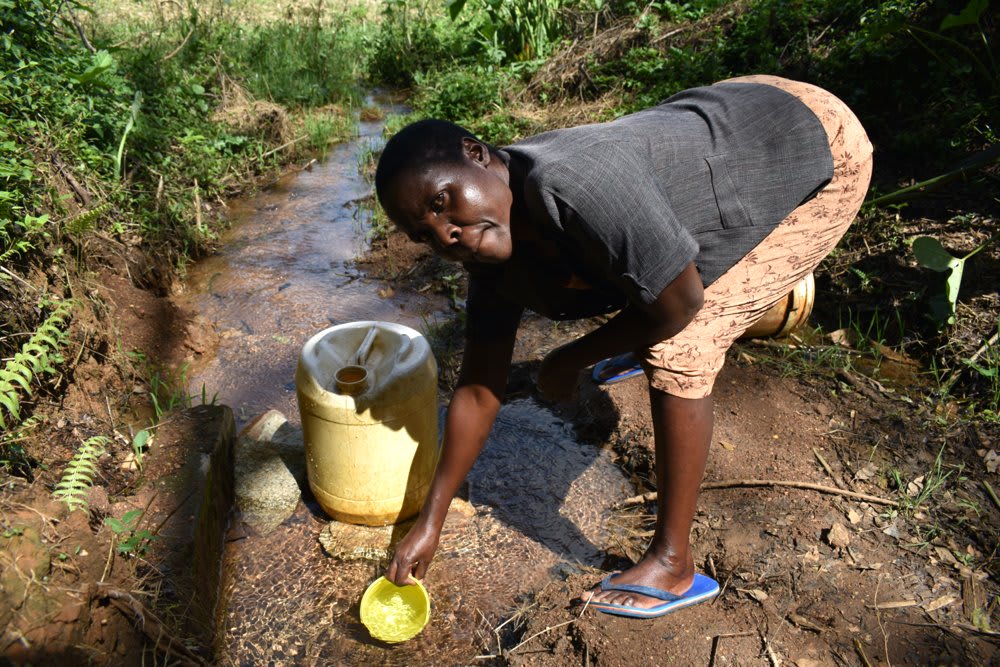June, 2021: Majimazuri Lusala Spring Project Complete!
Makhwabuye Community now has access to clean water! We transformed Majimazuri Lusala Spring into a flowing source of water, thanks to your donation. Our team protected the spring and trained the community on improved sanitation and hygiene practices, including COVID-19 prevention.

Women pose and celebrate at the completed spring.
"Access to this water point will impact my life and that of my family positively. This is because the water is now very clean, easily accessed, and the cost of buying treating agents like Waterguard is over. Boiling, at times, is not done, especially during rainy seasons when firewood becomes a challenge. All the cost incurred in the process of making the water clean and safe for use will be channeled to development, thus keeping me and my family safe and healthy," said Shadrack Lusala Mukwe, a businessperson in the community.
"My plans and goals that will be achieved are about farming because now I have enough water which I can easily pump to my piece of land. I will save a lot of time and also will have enough food for my family and the people of the Makhwavuye community."

Children were just as excited as the adults about the new water point.
"Access to safe and clean water will help me save time taken to get to the spring to get water, and also improve my safety. It has been so bad getting water and also carrying it home. The area was muddy and so slippery, but we are happy people, for God has remembered us," said teenager Loice.
"I can now plan my time and studies well. Initially, I could take thirty minutes to get water, but now I use seven minutes. I can proudly say I will achieve my education goal."

"This has been the best community ever that I have worked with," reported the lead Field Officer for the project Jemimah Khasoha. "Their commitment and cooperation were so selfless. Six to eight men were available every day of construction to help in the construction work. This was amazing and made construction very smooth, and the work is perfectly done. The locally available materials were availed wholeheartedly, thus making the work good. It was so nice working with this community."

Preparing for Spring Protection
Community members worked together to source and carried all locally available construction materials to the spring. These included bricks, sand, stones, and fencing poles. Some people also chiseled away at large stones to break them down into the gravel. Because people have to carry most items by hand, the materials collection process can take anywhere from a few weeks to months.

A boy carries a piece of sod to be transplanted at the spring.
When we prepared everything, we sent a lorry to the community to deliver the rest of the construction materials, including the cement, plastic tarps, and hardware. Then, our artisan and field officers deployed to the spring to begin work. Individual households provided meals throughout each day to sustain the work team.
From Open Source to Protected Spring: A Step-by-Step Process
At last, it was time to dig in at the spring! Women and men lent their strength to the artisan each day to help with the manual labor. First, we cleared and excavated the spring area. We dug a drainage channel below the spring and several surface runoff diversion channels above and around the spring. These help to divert environmental contaminants carried by the rains away from the spring.

Excavation
To ensure community members could still fetch water throughout the construction process, we also dug temporary diversion channels from the spring’s eye around the construction site. This allowed water to flow without severely disrupting community members’ water needs or the construction work.

Laying the foundation
Excavation created space for setting the spring’s foundation made of thick plastic tarp, wire mesh, concrete, and waterproof cement. After setting the base, we started brickwork to build the headwall, wing walls, and stairs.

Bricklaying
Next, we began one of the most crucial spring protection steps to ensure a fully functional water point: setting the discharge pipe. This spring had such a naturally high yield that the artisan decided to install two discharge pipes to match the spring's force. The discharge pipes have to be low enough in the headwall so that the water level inside never rises above the spring’s eye, yet high enough to leave eighteen to twenty inches between the pipes and the spring floor. This allows room for the average jerrycan (a 20-liter container) to sit beneath the pipes without making contact.

Setting the pipes
If the discharge pipes were placed too high above the spring’s eye, too much backpressure could force the flow to emerge elsewhere. Too low, and community members would not be able to access the water easily. We embedded the pipes using clay (or mortar when the clay is in short supply) and placed it slightly incline to ensure water flows in the right direction.

Stone pitching
In coordination with brickwork, we pitched medium to large stones on both sides of the spring’s drainage channel. We then cemented and plastered each stone group into place, forming the rub walls. These help discourage people and animals from standing on that area, which could cause soil erosion and thus a clogged drainage area.

Stairs construction
We turned to cementing and plastering both sides of the headwall and wing walls with brickwork and stone pitching completed. These finishing layers reinforce the brickwork and prevent water in the reservoir from seeping through the walls. In turn, enough pressure builds in the reservoir box to push water out through the discharge pipe.

Plastering
As the headwall and wing walls were curing, we cemented and plastered the stairs and installed four tiles beneath the discharge pipe. The tiles protect the concrete from the falling water’s erosive force while beautifying the spring and facilitating easy cleaning of the spring floor.

Backfilling
We transitioned to the final stages of construction with the tiles in place - backfilling the reservoir box. First, we cleared the collection box of any debris that may have fallen in since its construction, such as dead leaves or other items. Then we redirected the temporary diversion channels back into the reservoir box, channeling water into this area for the first time. We closed off all of the other exits to start forcing the water through the discharge pipes only.

Transplanting grass
With much help from the community, we filled up the reservoir area with the clean and large stones they gathered, arranging them in layers like a well-fitting puzzle. We covered the stones with a thick plastic tarp to minimize potential contamination sources from aboveground, followed by a layer of soil. We piled enough soil on top to create a slight mound to compensate for the backfill’s future settlement.

Fencing
Community members transplanted grass onto the backfilled soil to help prevent erosion. Finally, the collection area was fenced to discourage any person or animal from walking on it since compaction can lead to disturbances in the backfill layers and potentially compromise water quality.
The entire construction process took about two weeks of work and patience to allow the cement and plaster to finish curing. As soon as it was ready, people got the okay from our field officers to fetch water.

Upon completing the construction process, the community members gathered at the spring to see how our team did the work. Their faces and speeches made them extremely happy, saying that we did the work very well. Mr. Peter boldly said in the whole village. There is not any other spring that can reach that standard. He further said that the member of the County Assembly helps people in accessing water, but his standards can not be compared to the one they received. He praised and appreciated the artisan whom he termed to be very humble, faithful, and very steady in his work. Mr. Peter thus was very grateful and passed his sincere gratitude to all the funders of the project.

Training on Health, Hygiene, COVID-19, and More
Due to the ongoing challenges and restrictions amidst the pandemic, we worked with local leaders and the national Ministry of Health to gain approval for a small group training about health, hygiene, and COVID-19 prevention.
Together with the community, we found their preferred date for training while considering other community calendar events, such as the agricultural season and social events. We requested a representative group of community members to attend training to relay the information learned to the rest of their family and friends.

Trainer Jemimah shows how to make and use a leaky tin handwashing station.
When the day arrived facilitators, Jemmimah Khasoha and Samuel Simidi deployed to the site to lead the event. Fourteen people attended the training, including self-help group members. We held the training under the trees adjacent to the spring. This was an ample, cool, and quiet place for the trees to provide shade and fresh air.
The environment was conducive in that it was free from noise and other disruptions. It was also a good place because it saved time during onsite training, for it took us just seconds to be at the water point. The area was also wide enough for everyone who attended to sit comfortably and listen while keeping a physical distance. Our only surprise for the day was the majority of men who turned up, as it is usually the women who come to training in large numbers. In this case, only two of the fourteen attendees were women.

Handwashing demonstration
Perhaps the most crucial topic of the day was our session on COVID-19 prevention and control. Due to the rampant spread of misinformation about COVID-19, we dedicated time to a question and answer session to help debunk rumors about the virus and provide extra information where needed.

Handwashing practice
We covered several other topics, including community participation in the project; leadership and governance; personal and environmental hygiene; water handling and treatment; operation and maintenance of the spring; dental hygiene; the ten steps of handwashing, and how to make and use a tippy tap and leaky tin. We held an election for the newly formed water user committee leaders during the leadership and governance session.

Trainer Sam shows how to build a simple kitchen garden using recycled containers and drip irrigation.
We also brainstormed income-generating activities that can be used to start community savings account for any future minor repairs to the spring and a cooperative lending group to enable members to develop small businesses.
The most memorable topic was food hygiene. The participants, despite having big land for farming, lack food to sustain their families. People have to go to the market to get vegetables and other farm products. At this time, the facilitators demonstrated how to build a simple, small kitchen garden and its benefits. The group discussed how kitchen gardens are one way to save money, have fresh products free from genetically modified organisms, save time, and stay busy. We also discussed income-generating activities like having trees, including fruit tree nurseries, which are a good source of income.

Explaining the solar disinfection method of water treatment.
"The training was very valuable for the trainers touched our lives and enlightened us on the issues that affect us directly. I have learned a new skill on making good use of the resources that God has freely given us. These are water, land, and knowledge. I gained new skills in hygiene, farming, and social-economic empowerment. These new skills will help me take care of my family and also rise in my financial status," said Valentine Lusala, a farmer and the water user committee's elected Secretary.
"The training was very informative. I learned that you need the knowledge to be successful in life. The trainers gave us information full pack, and so my life has been impacted positively," said Bonface Bunguswa, also a farmer and the community mobilizer.

Bonface Bunguswa
"One area that I had been ignorant of for a long time was handwashing. After the training, I learned that our hands are the main source of germs catchment. This is because they touch each and everything we have, that is, our body, food, and every other thing. They need to be kept clean always for good health and also prevention of diseases and illness," Bonface said.
"Many of the community members believed that Covid was far from them and that it is in the city. Thus we did not take the steps seriously. The steps were being announced and talked of in the media, but people were not observing them here in the village," he continued.

Onsite training about spring maintenance.
"The most helpful part received during the Covid training was information. This is because the team would elaborate in our language so that we could understand well. From the television or radio, we could hear, but it was not well explained like the way we were taught in the training."
"After receiving the information, we have decided to be washing our hands using the leaky tins that we were showed how to make. We will ensure social distancing is maintained and also avoid contact greetings. The virus came in as a big and a great monster that took away many lives, but now I feel that people have adjusted and accepted to live with it without worries."

When an issue arises concerning the water project, the water user committee is equipped with the necessary skills to rectify the problem and ensure the water point works appropriately. However, if the issue is beyond their capabilities, they can contact our field officers to assist them. Also, we will continue to offer them unmatchable support as a part of our ongoing monitoring and maintenance program.
Thank you for making all of this possible!



 Protected Spring
Protected Spring
 Rehabilitation Project
Rehabilitation Project













































